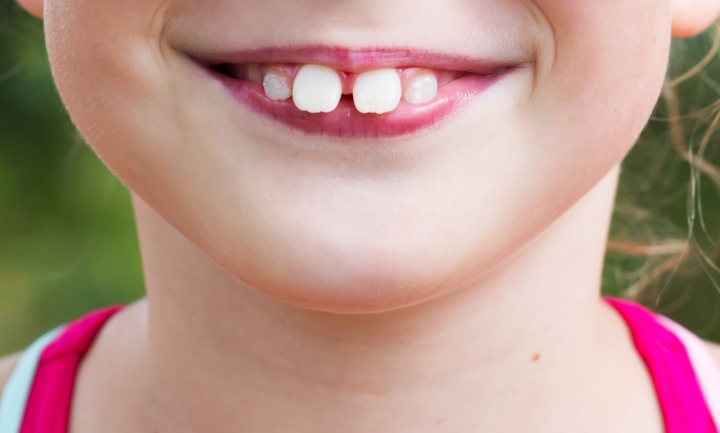Buck teeth, also known as protruding teeth or overjet, refer to a dental condition where the upper front teeth protrude significantly beyond the lower front teeth when the mouth is closed. This common orthodontic issue can impact both children and adults, leading to various functional and aesthetic concerns. This can be caused by various factors, including genetics, thumb-sucking, tongue thrusting, and jaw misalignment. This condition can not only affect the aesthetics of a person’s smile but also lead to various health risks if left untreated. In this article, we will explore the causes of buck teeth, the health risks associated with this condition, the treatment options available, and how to manage buck teeth in kids.
In This Article:
- Causes of Buck Teeth
- Risks Associated with Buck Teeth
- Treatment Options for Buck Teeth
- Managing Buck Teeth in Kids
Causes of Buck Teeth
There are several possible causes of buck teeth, including:
Genetics
One of the most significant factors contributing to buck teeth is genetics. If a family member has this condition, there is a high chance that their offspring may develop it as well.
Thumb-Sucking
Children who suck their thumbs or fingers beyond the age of four or five can develop buck teeth as the habit puts pressure on the upper teeth, causing them to move forward.
Tongue-Thrusting
Tongue-thrusting is another common habit that can cause buck teeth. This occurs when the tongue pushes against the back of the upper teeth, creating pressure that can lead to misalignment.
Mouth-Breathing
People who breathe through their mouths instead of their noses can also develop buck teeth. This is because mouth-breathing puts pressure on the teeth and jaws, causing the upper teeth to protrude forward.
Teeth Grinding
Bruxism, or teeth grinding, can also cause buck teeth. This habit puts pressure on the teeth, causing them to move forward and become misaligned over time.
Risks Associated with Buck Teeth
Dental Trauma
One of the primary risks associated with buck teeth is dental trauma. Since the upper front teeth are more exposed, they are more likely to get damaged in the event of an impact. This can lead to fractures, chips, or even complete tooth loss. Dental trauma can be painful and can cause significant discomfort, especially if it affects the nerves.
Gum Disease
Another risk associated with buck teeth is gum disease. When the upper front teeth protrude, they create pockets between the teeth and the gums. These pockets can trap food particles and bacteria, which can lead to the development of gum disease. Gum disease can cause swelling, bleeding, and even tooth loss if left untreated.
Speech Problems
Buck teeth can also lead to speech problems. Since the upper front teeth are responsible for articulating several sounds, their misalignment can affect speech. People with buck teeth may find it challenging to pronounce certain words, which can lead to communication problems. This can be especially challenging for children, as it can affect their ability to learn and socialise.
Low Self-Esteem
In addition to these risks, buck teeth can also affect a person’s self-esteem. People with buck teeth may feel self-conscious about their appearance, which can affect their social lives and relationships. This can lead to anxiety, depression, and other mental health issues.
Treatment Options for Buck Teeth
Braces
One of the most common treatment options for buck teeth is braces. Braces work by applying pressure to the teeth, gradually moving them into the correct position. In cases of buck teeth, braces can help to pull the teeth back into the correct position, reducing the protrusion.
Clear Aligners
Another treatment option for buck teeth is clear aligners. Clear aligners work in a similar way to braces, applying pressure to the teeth to move them into the correct position. However, clear aligners are often more discreet than braces, as they are made from clear plastic and are almost invisible.
Orthognathic Surgery
Orthognathic surgery involves repositioning the jaw to correct dental issues. In cases of buck teeth, the surgery can help to move the upper jaw back, reducing the protrusion of the teeth. Orthognathic surgery is a more invasive treatment option and requires a longer recovery time than braces or clear aligners.
Veneers
Veneers are thin, tooth-coloured shells that are bonded to the front surface of the teeth. They can be used to correct a variety of dental issues, including buck teeth. Veneers are a long-term solution, and the treatment can take anywhere from 2 to 4 weeks.
Managing Buck Teeth in Kids
When it comes to managing buck teeth in kids, early intervention is key. By addressing the issue early on, you can prevent potential dental problems down the road. Encouraging proper oral habits and regular dental visits are crucial steps in managing buck teeth.
Early Intervention Strategies
Introducing habits such as proper tongue posture and discouraging thumb sucking can help guide children’s teeth into the correct position from an early age. Orthognathic intervention may be necessary in some cases to address severe misalignment.
Dental Visits and Monitoring
Regular dental check-ups are essential for monitoring the development of your child’s teeth. Your dentist can provide valuable insights and recommend appropriate treatment if needed to manage buck teeth effectively.
Conclusion
In conclusion, buck teeth can pose both aesthetic and health concerns if left untreated. As we’ve explored the causes, risks, treatment options, and management strategies for buck teeth, it’s evident that early intervention and proper dental care play crucial roles in addressing this common orthodontic issue. By understanding the causes, risks, treatment options, and how to manage buck teeth in kids, individuals can take proactive steps to address this condition and achieve a healthier, more confident smile. By taking proactive steps to manage buck teeth, parents can help their kids achieve a healthy and confident smile. Remember to consult with a qualified orthodontist or dentist for personalised advice and treatment recommendations tailored to your specific needs. Stay proactive in your dental health journey to ensure a bright and healthy smile for years to come.
Sources:
2. https://www.healthline.com/health/buck-teeth













